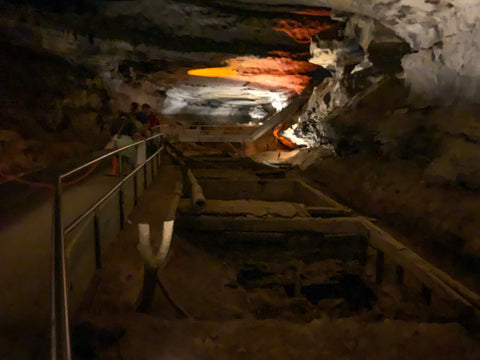
Located within Kentucky’s iconic rolling hills, Mammoth Cave National Park is a nature lovers wonderland filled with underground and above ground activities. With 84 miles of mixed use trails, 20 miles of which surround the visitors center, one doesn’t need to venture far in order to satisfy their sense of adventure. I often bring my family here on day trips, especially during the fall season to enjoy the colorful hillside overlooks along many of the hiking trails. As predictable as children may be, I always anticipate getting asked wether we may go on one of the many cave tours offered here.

As the central feature of this National Park, Mammoth Cave offers 19 different cave tours at any given time. From the Violet City Lantern Tour, which travels exclusively by lantern light giving you the same experience as the earliest explorers in Mammoth Cave, to the parks most famous tour, the Frozen Niagara Tour. During the time of Covid-19, while keeping public safety and the need for social distancing in enclosed spaces in mind, the park service made the decision to temporarily suspend most tours with the exception of the Self Guided Extended Historic Tour. Even though we will be free to roam 2 miles of the cave on our own, along the route stationed in key points, are National Park Rangers ready to explain fun bits of knowledge about the caves history.

With tickets in hand, we headed down the paved trail towards Mammoth Caves' iconic entrance. Walking down the 80 steps into the mouth of the cave, just underneath the streaming waterfall, never gets old. As we head closer to the gated entrance, the caves chilled air reminds me that I forgot to bring a sweater, as per usual. With a year round temperature of 54* F, it might as well be -10*F when you’re walking in there wearing just shorts and a tee shirt.

Entering Houchins Narrows, just past the gated entrance, the underground trail begins its descent into the 2 mile long labyrinth open to this tour. This passage is named for John Houchins, who, according to legend discovered the entrance to Mammoth Cave while hunting for black bears in the 1790’s. Although that is the earliest recorded encounter of a European American venturing into the cave, people from the Late Archaic and Early Woodland Indian periods were using the cave as far back as 5,000 BCE.

Venturing deeper into the cave we enter the first large room, the Rotunda. Named for the circular break out dome in the ceiling, this is the room that gave birth to the cave being called “Mammoth”. With its proximity to the caves entrance, this was the first area where early settlers began mining for saltpeter, an ingredient used for food preservation and gunpowder. In the center of the room you can view whats left of the three vats and pump tower that once operated in this room during the early 1800’s.

From here, the path has a two way split and after a quick look at our map, decided to head right towards Audubon Avenue. Named for the famous ornithologist and painter, John James Audubon spent a great deal of time in Kentucky, eventually striking a friendship with cave owner John Croghan. Walking along this tunnel we spotted several shadows flying above us, which gave rise to this section being called Great Bat Avenue. A short passage just to our left, with its end completely shrouded in darkness, houses many of the nesting bats in this area of the cave. With the onset of White Nose Syndrome, the bat population in Mammoth Cave is but a fraction of what it once was.

Walking up and over a large earthen mound, we begin descending into Rafinseque Hall. This large canyon like passage was named for Kentucky naturalist, Constantine Samuel Raphinesque. This is one of the few spaces in Mammoth Cave to regularly host large events. The Friends of Mammoth Cave host an annual event celebrating its 40th year here called, Cave Sing. Each year, during the month of December, a different musical group puts on a free show presenting traditional holiday music a cappella.

Veering to our left, we climb up to the Lookout Mountain overlook. To the naked eye this looks like just another dead end. This passageways collapse is a result of thousands of years worth of erosion, turning layers of limestone and sandstone into dust, causing the caves ceiling and the hillside above to cave into itself. If you were to excavate away all of the rubble just ahead, you would see a small valley on the other side. The same weathering that has blessed Kentucky with the natural arches of Red River Gorge is also at play here in the cave.

From here, we turned around and began heading back to the Rotunda. Once there we made a sharp right turn just past the saltpeter vats in the center of the room. This path has often been described as resembling the urban canyon of Broadway in New York City, if you were to replace the skyscrapers with giant fragments of rock. At certain points you really feel like you’re being swallowed whole by the enormity of this cave. The area of the cave we are in right now, is what most people refer to when they talk about the “Main Cave”.

Following a long stroll, we reached a ramp flanked by whats left of an old aqueduct used to supply the deeper portions of the cave with fresh water. At the bottom of the ramp is a large gathering space known as the Church. Throughout its history the cave has had many uses, including that of holding religious services in this very space. A towering rock lookout just above the main space, Pulpit Rock, was often used as a podium from which a pastor would preach his sermons to the crowd of worshippers below. Nowadays, most of the people seated here seemed more interested in enjoying a quiet lunch.

Moving on, the trail gets tight as it passes an area that once housed seven saltpeter vats and a pump tower. During the War of 1812, this cave alone supplied the American war effort with four hundred thousand pounds of saltpeter. It was during this cave mining that a rich assortment of ancient artifacts were discovered. Sheltered by the cave environment, torches, gourd bowls, woven cloth, and even bare footprints have persisted and given insight into how our early ancestors lived in the area surrounding Mammoth Cave.

A small staircase jutting out over the saltpeter vats, leads to a rock promenade known as Booths Amphitheater. Brother of John Wilkes Booth, President Lincoln's assassinator, Edwin Thomas Booth was an American actor who toured throughout the United States and Europe, performing Shakespearean plays. In 1876, he gave a recital of Hamlets soliloquy from the natural stage just past here. This staircase is also the beginning of the Gothic Avenue Tour which showcases a variety of unusual rock formations resembling gothic architecture along with Tower Rock, the stage used for Booths performance.

At this point, we are roughly just past the halfway point to the end of our tour along the main cave passage. Its really quite easy to make out a lot of the special features down here as they are well lit with spotlights. One of the main natural landmarks down here is the Water Clock. An active solution domepit, it extends twenty feet below the trail along the cave wall. In normal flow, water enters the pit in a steady, metronomic drip, creating the clock effect. This naturally occurring phenomenon is similar to a man made device created by ancient Egyptians as a means for measuring time by the gradual flow of water in the 14th century B.C.E.

Heading deeper into the cave, the trail begins a tight squeeze against the large mass of boulders piled up on the right. As with most instances when you’re eyes are deprived of light, shadows begin to take on eerie shapes. One of the most interesting landmarks down here is the Giants Coffin. Even photographs from high above the rock confirm its uncanny resemblance to that of a large coffin. At forty feet long, twenty wide, and eight feet deep, it takes little effort to start imagining what on earth could be inside of that rock.

The giant slab itself hides the secret entrance to Dantes Gateway, a passage that leads down to deeper levels of the cave. Several tours including River Styx, Violet City, and Star Chamber, begin here. Just around the bend, passing the caves Acute Angle, a section of passage that makes a sharp left turn, is Harveys Avenue. Named for Charles Harvey, a nephew of early cave owner Franklin Gorin, whom at one point got lost in the cave for thirty nine hours.

This incident is believed to have sparked a renewed interest in the exploration and mapping of Mammoth Cave. During this time, veteran guides Stephen Bishop, Mat and Nick Bransford, ushered in an era of new passage discoveries that would eventually lead to the mapping of 412 miles of underground passageways and the title of longest cave system on Earth.

With that in mind, we reached the end of our tour at the infamous, Tuberculosis Huts. Two stone structures built built for tuberculosis patients during Dr. John Croghans ownership of the cave. Believing that the cave air had healing properties, in 1842 a medical experiment was conducted in the cave using patients suffering with TB. Much like the movement towards the clean mountain air of the time, the hypothesis that fresh cave air would endure a curative response to the ailments of tuberculosis, proved to be false and was eventually abandoned.

Even though I’ve taken this tour on half a dozen separate occasions since first coming here 15 years ago, this particular experience gave it a fresh feel to it. Having the opportunity to walk the passageways all on our own, stopping to take as many breaks and photo ops as we wanted, really made a difference in our overall enjoyment. Instead of being presented with a canned, and seemingly overdone tour monologue, the rangers posted along our route had a more relaxed vibe.

They joked around with us openly while also giving us tid bits of their favorite experiences in the cave. It made for an all around enjoyable experience that I think other visitors would agree made the best of an otherwise difficult decision to dial back the caves accessibility during these difficult times. If you find yourself in central Kentucky, make a point to visit Mammoth Cave and explore the longest cave system in the world. See y’all on the trails!









0 comments